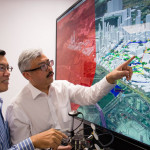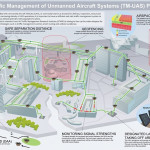
WHY THIS MATTERS IN BRIEF
- With our skies due to fill up over the coming decades with more and more drones authorities are in a race to try to find new ways to manage and secure their airspace before disasters happen
Over the next decade our skies will be increasingly packed with drones as they whizz around rural and urban airspace delivering everything from donuts, and TV’s to medicine and even people, then, throw in the opportunity for terrorists to use drones for mischief and from an air traffic control point of view you have a new world order that sends shivers up your spine. Now a team at Nanyang Technological University (NTU), in Singapore, is developing an air traffic control system for drones in Singaporean airspace, and they’re exploring ideas like geofencing, designated flight lanes and ground stations that track all airborne UAVs.
Singapore isn’t alone in trying to tackle the upcoming tsunami – in the US the Federal Aviation Authority (FAA) has slowly been relaxing its restrictions on drones, particularly drone deliveries, and they’ve been working alongside DARPA to try to come up with a new drone dragnet surveillance system, and Australia, Canada and the UK are all beginning to follow in their footsteps.
The NTU project is borrowing some of these ideas and developing new ones, then studying how they can fit the needs of Singapore and the Asia Pacific region in general.
“At NTU, we have already demonstrated viable technologies such as UAV convoys, formation flying and logistics, which will soon become mainstream,” says Professor Low Kin Huat, lead researcher on the project, “this new traffic management project will test some of the new concepts developed with the aim of achieving safe and efficient drone traffic in our urban airways.”
The system will be made up of designated take off and landing zones, and once in the air, the drones would be directed along specified corridors, essentially building an invisible system of corridors in the air. Sensitive locations, like airports and power stations, who are also building out their own defences, could be geofenced off, to prevent wandering UAVs from taking any potentially hazardous shortcuts.
Coordinating stations may be established to keep everything in order. From these facilities, aerial traffic can be monitored and adjusted, making sure the drones are flying where they’re supposed to, at the right speeds, and at a safe distance apart from each other.
Current technology might not be up to the task of putting these ideas into practice just yet, so another aim of the project is to research and develop drone systems that can handle smart and safe path-finding, collision detection and avoidance. Autonomous vehicles and some higher end drones, such as the ones demonstrated by Skydio have already mastered some of these skills, so they shouldn’t be too far out of reach – it’s a matter of designing drones that seamlessly slot into the proposed network.
The bigger challenge in setting up a system like this might be the legal and safety issues that arise. To help direct the regulations surrounding the implementation, the team is running computer simulations of various scenarios to determine the safest and most efficient routes, altitudes and emergency procedures.
“We will also look into proposing safety standards, for instance how high UAVs should fly and how far they should be flying above buildings, taking privacy concerns and laws into consideration, and to suggest recommended actions during contingencies,” says co-investigator, Mohamed Faisal Bin Mohamed Salleh.
Phase one of the project will be completed later in 2017 with first trial flights and tests slated for 2018, so as traffic management operators say – watch this space.



















[…] Source link […]